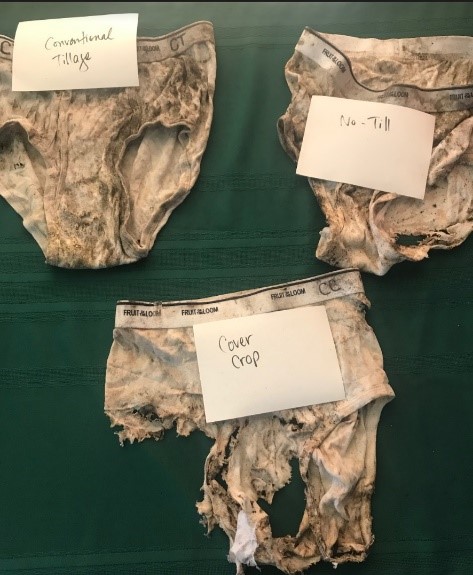In modern production agriculture, sometimes we need to see proof before we can believe.
Every year growers perform on-farm research trials to search for a yield advantage from seed selection, herbicide application, fungicide application, seed treatment and the list goes on. In most cases these tests result in positive or negative yield responses and a corresponding positive, negative or flat return on investment.
It’s typically hard to put a financial value on the concept of soil health, for the simple reason there are so many variables and it’s a system or ecosystem that takes time—more than one growing season or even two growing seasons—to evaluate appropriately. At the 2019 Farm Progress Show, the Illinois CCA booth featured a thought-provoking display that not only sparked conversations over soil health, but showed producers how they can evaluate soil health on their own fields with different management practices.
As the image shows, a test was conducted by burying

cotton underwear in three different soil systems to showcase the product deterioration over time due to microorganisms in the soil.
- Conventional tillage
- No-till
- Cover crops
Since the underwear is pure cotton (carbon), the soil bacteria would have fast and aggressive interaction to break the fabric down (with a healthy population). Just like when corn, soybean and wheat residue enter the soil, it’s the soil bacteria that break it down. This process allows nutrients to be available to future crops and will allow the remaining material to live on as organic matter.
It’s the soil health and all the living organisms that help to sustain a crop during the good and bad times and it’s important to properly manage soils not only for the coming crop, but for several crops to come. Soil is a nonrenewable resource that we must protect and respect.
This soil health test can be conducted by anyone and really at any time. See instructions below for how to replicate this test on your farm and in your soils.
How to replicate this test:
- 100% cotton underwear or shirt
- Place the item below the soil
- Flag where the test is being conducted
- Return 3-4 months later to determine results.
When to test:
- Same time the crop is growing to evaluate soil microorganism activity
- Same time when corn stalk residue is being broken down (fall to early spring)
 cotton underwear in three different soil systems to showcase the product deterioration over time due to microorganisms in the soil.
cotton underwear in three different soil systems to showcase the product deterioration over time due to microorganisms in the soil.



 and then
and then